Breaking Beta | Can We Minimize Tendon Injury and Return More Quickly to Climbing?
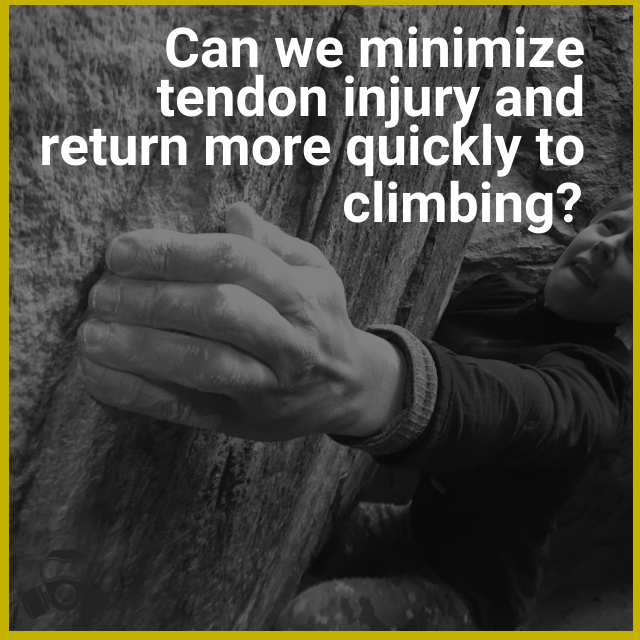
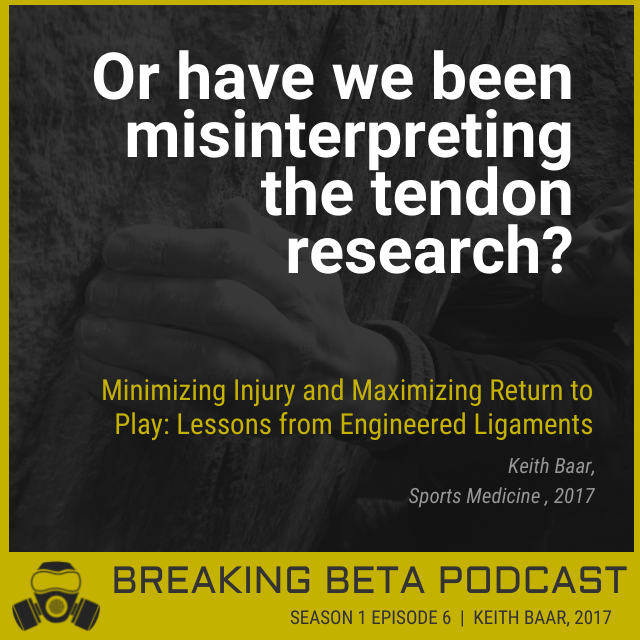
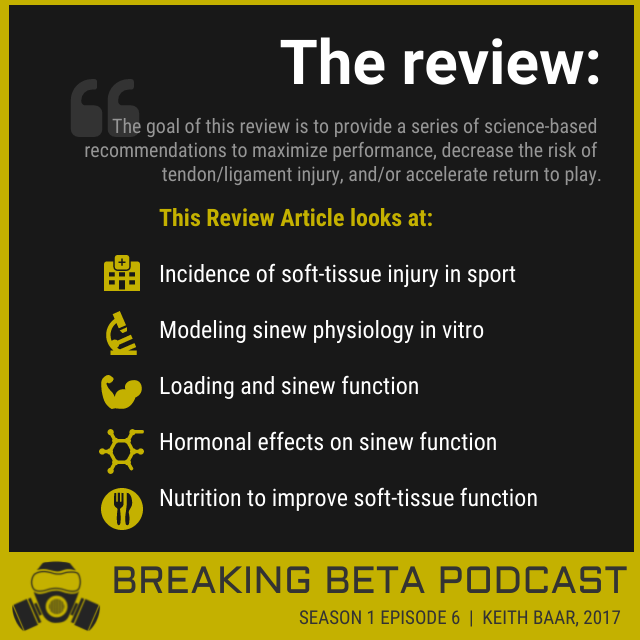

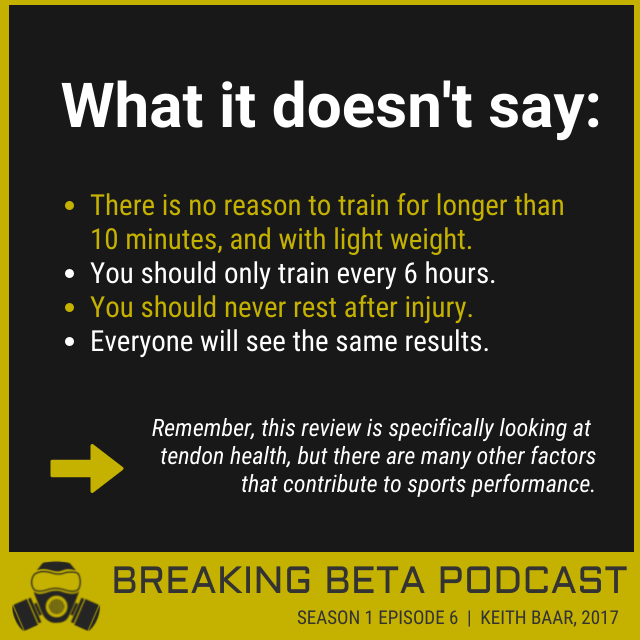
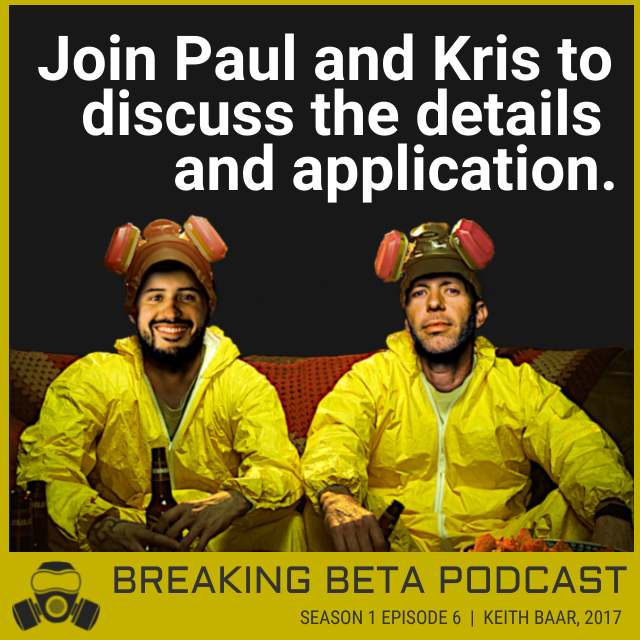
In this episode, Kris and Paul discuss another study examining a type of injury commonly seen in climbers:
Minimizing Injury and Maximizing Return to Play: Lessons from Engineered Ligaments
authored by Keith Baar; published in Sports Medicine (Springer Nature) in 2017.
They’ll attempt to determine whether or not there’s much we can do to help prevent tendon injuries and speed up recovery time when they do occur. Tune in to find out if that friend who swears their collagen supplements are the key to their fingers of steel is actually on to something, or totally full of it.
*Additional studies/resources mentioned in this episode:
Stress Relaxation and Targeted Nutrition to Treat Patellar Tendinopathy authored by Keith Baar; published in the International Journal of Sport Nutrition and Exercise Metabolism, 2018.
New episodes of Breaking Beta drop on Wednesdays. Make sure you’re subscribed, leave us a review, and share!
And tell all of your friends who keep telling you that you should rest every single one of your tendon tweaks until they're gone, that you have the perfect podcast for them.
Got a question? Comments? Want to suggest a paper to be discussed? Get in touch and let us know!
Breaking Beta is brought to you by Power Company Climbing and Crux Conditioning, and is a proud member of the Plug Tone Audio Collective. Find full episode transcripts, citations, and more at our website.
FULL EPISODE TRANSCRIPT:
Breaking Bad Audio Clip 00:05
This investigation, Hank, you realize what this will do to him, hearing these things?
He's gonna hear it when I kicked in the front door and arrest you.
If that day ever comes, so be it. You have no evidence to support your claims. Why tear this family apart?
So how about that guacamole?
Kris Hampton 00:35
I play that clip, because that isn't the case here. There's lots of evidence to back up the claims we're going to be talking about today and, and I love it. This is one of those instances where science works like it's supposed to and that's really exciting. But first, before we jump into that, how the hell are you?
Paul Corsaro 00:58
I'm pretty good. Just you know, digging into the climbing season. It's getting cold here in Chattanooga. We had our first wonderful weekend of climbing recently. I sat it out, because I'm dealing with a knee tweak, but that's getting better. I'm using, actually, some of the methods we may be talking about later in this podcast. But things are good in Chattanooga. Excited for the season. How about you? Where are you at today?
Kris Hampton 01:21
I am in Las Vegas, where I've switched time zones, and there's Daylight Savings Time and my computer didn't update and I'm all over the damn place. Confusion. That's how it all feels. And I totally didn't plan the fact that you just injured your knee and you're going to be using some of these methods in your rehab, but I think it's really relevant, so I am I'm, I'm not happy that that happened, but, you know...
Paul Corsaro 01:52
It was interesting rereading these papers with the personal context, you know, over this weekend looking into it and thinking about, "Oh, how can I use this for me?", selfishly, because I don't want to be hurting much longer. I don't plan on being hurting much longer either.
Kris Hampton 02:06
Good. The the paper we're talking about today is from Keith Baar. He is likely the most well known name in tendon health research, along with I think Ebonie Rio, and I believe Jill Scott. I think I'm getting that right. That's also a singer, so maybe I'm not but something to that effect. And the title of this paper is "Minimizing Injury and Maximizing Return To Play: Lessons From Engineered Ligaments" from Keith Baar. Published in the Sports Medicine Journal from Springer Nature Journals in 2017. And the purpose of this paper was to provide a series of science based recommendations to maximize performance, decrease the risk of tendon ligament injury, and or accelerate return to play, something almost all of us at some point deal with to some degree.
Paul Corsaro 03:06
I think yeah, especially the longer you're in the sport, we challenge our bodies past, you know, the stress we put on our system and just activities of daily life. So, you know, odds are we may strain the soft tissue more than it's used to and to get back to where we need to be, you know, we need to know how to do that. And we need to know how to do it quickly, safely and effectively.
Kris Hampton 03:28
Yep, totally. And we're also going to be taking a look at, throughout this episode, a case study, also by Keith Baar, that uses a lot of these methods he's talking about. The case study is titled "Stress, Relaxation and Targeted Nutrition To Treat Patellar Tendinopathy." and that's from the International Journal of Sport, Nutrition and Exercise Metabolism from 2018. So you'll hear us referencing back to that pretty often throughout this episode.
Paul Corsaro 03:59
I think that's cool, too, because we know we've done a review before, we've done a bunch of controlled trials, this is the first case study we've done. Um, it just goes to show there's a bunch of different types of research that's out there and maybe a case study might not have, you know, a solid throughline, this is how you need to do something. But it's a good example of something put into practice with one person where you can get a little bit more in depth into the methods for that one person and you can use that as a piece of guidance to how you can go about things. But I wouldn't go with changing a whole training program or developing your whole training model based on a case study. So it's a piece of the evidence but I really wouldn't take that whole one as a whole part of the evidence. So something to keep in mind as you stumble across different types of research and experiments that are out there.
Kris Hampton 04:49
Yeah, absolutely. And especially when you're able to connect the dots with things you know, like with this tendon research, there's so much of it, you know, similar to the stretching studies that we looked at. There's so much of that research and Keith Baar is one of these researchers who, who is asking lots of different questions with lots of different parameters, and is able to look at the whole body of research and then provide us with both this review and a case study that match up really well together. So, for me, that's really fun to be able to look in and be able to connect these dots.
Paul Corsaro 05:26
Yeah, me too. It's, it's cool to dig in and try and figure out an understanding of all this.
Kris Hampton 05:32
Yeah. Alright, let's get this thing started.
Breaking Bad Audio Clip 05:36
You clearly don't know who you're talking to, so let me clue you in.
Paul Corsaro 05:40
I'm Paul Corsaro.
Kris Hampton 05:42
I'm Kris Hampton.
Breaking Bad Audio Clip 05:43
Lucky two guys, but just guys, okay?
Paul Corsaro 05:47
And you're listening to Breaking Beta
Kris Hampton 05:50
Where we explore and explain the science of climbing
Breaking Bad Audio Clip 05:53
With our skills, you'll earn more than you ever would on your own.
Breaking Bad Audio Clip 05:58
We've got work to do. Are you ready?
Paul Corsaro 06:03
I'm ready, are you?
Kris Hampton 06:05
I was ready an hour ago when I thought that it was one o'clock and it was not. Because like I said, my whole day, in terms of time has been confusion. So now, in fact, I am ready. Let's jump right into these methods.
Breaking Bad Audio Clip 06:24
In a scenario like this, I don't suppose it is bad form to just flip a coin.
Kris Hampton 06:31
Let's talk about that the first paper, what did those methods look like?
Paul Corsaro 06:35
So when we're talking about the minimizing injury and return to play paper, one of the difficulties with doing research on tendons is the core of the tendon turns over very slowly, so it's hard to really understand how the cells in an adult respond to how you load or provide nutrition to the tendon. That's always been one of the challenges for figuring out exactly how do we cause these changes in the tissue we want to change. So Keith and his colleagues, they did a pretty cool thing here, where they were able to get tissue from the remnants of ruptured ACLs that they collected when they were repairing ACLs on people. And they were able to place that in an experimental setup. They had, you know, I'm not super familiar with a lot of the biology behind all of this, but they were basically able to recreate a model of a tendon. So a couple things I thought that were cool with that were they used it from the same donor, so they eliminated any genetic differences between subjects. Which I thought that would be neat, because, you know, they could be make make things pretty repeatable with these studies.
Kris Hampton 07:40
Sure.
Paul Corsaro 07:41
Maybe get a little bit more clear understanding on the certain things they're trying to find out.
Breaking Bad Audio Clip 07:45
Yeah, science!
Paul Corsaro 07:47
Basically, with these studies, or with these experiments they performed on these tissues, they were able to look at things such as you know, how you how the tissue responds to loading, how hormonal changes in the body affected that tissue, and how different methods of nutrition can affect that tissue as well. So it was able to create a model to kind of look at these changes. You know, all models are incorrect. Some are just more accurate than others, so this is just another step into just trying to understand what the truth is behind all of this. But I thought it was a pretty cool setup to maybe control things a little more than you can when just performing surveys or talking to people, or, you know, doing ultrasound or imagery on these tendons. You could actually look at things a little clearer.
Kris Hampton 08:34
Right. Yeah, I mean, you know, it would be great if we could do lots of research on healthy adult tendons in living people, but it's, it's pretty hard to get a bunch of people who are willing to just say, "Oh, yeah, cut my tendons, that's fine. You know, take a look at them whenever you want. Just come on in here." So this seems like the the next best thing.
Paul Corsaro 09:00
Absolutely. And you know, a lot of the other instances where you're able to get access to some of these tissues, probably from people who were injured. There may be some structural issues going on people with tendinopathy, or you know, where there's disorganization in how we lay down these tissues, so maybe it's not a "healthy" per se, tissue. So this lets us kind of have a square one to test theories and see what pushes things forward.
Kris Hampton 09:26
Mm hmm. Yeah. And he mentions in here that, you know, like you said, these in vitro results have some significant differences compared to human tissue and he uses these results from the lab to compare against animal or human data wherever it's possible. And then they come up with suggestions in this review, for improving performance and maximizing the return to play for injured athletes.
Paul Corsaro 09:53
Yeah, so this is actually a paper that I would really recommend people to track down and try and read because I thought it was a great overview on a lot of things.
Kris Hampton 10:02
It's laid out so damn well.
Paul Corsaro 10:04
Mm hmm and it finished and we'll get to this later on, but it finished with really short but actionable pieces of information. So I thought it was a great thing that....a great paper that both went deep, but also was able to zoom out and give you the Cliff's Notes in an effective way as well.
Breaking Bad Audio Clip 10:17
We use a different chemical process, but it is every bit as pure.
Kris Hampton 10:21
Yeah. Love it. Talk to us about the case study methods.
Paul Corsaro 10:26
Yeah, so for the case study, they just really looked at the training program for, I believe it was a NBA athlete. I don't know, they don't really specify if he was playing like at the highest level, you know, on you know, those weeknight games or in the playoffs or things like that but I know he was part of an NBA program.
Kris Hampton 10:44
Yeah, he was... he was in games, I think an average of like 20 minutes or something to that effect. I might have that number wrong, but he's in there a fair amount.
Paul Corsaro 10:52
That's playing time, for sure. Like you're not just getting in every now and then. He's he's participating in that team. Yeah, basically, so they took this player, he had had knee pain for about five years, so this wasn't something that just popped up. He had a long term history of pain in the knee. That means there's probably something structural that's going on there. And they did some MRIs as they.... as this training plan started off and they followed up later. So they did the first MRI, that was right when the training plan began and then they got another MRI 15 months after the initial scan, and then six months after that. So they were able to kind of see how things changed as he went on through this training plan. And he went through kind of two parts of interventions here. So the first thing he did was he would do a loading protocol for stress relaxation, which basically just slowly gets that tendon to stretch, pretty much. And as that stretches under load, it causes changes to happen in the structure. It causes chemical changes to happen in the tendon and the hypothesis was that that would help clear up some of this knee pain and also build strength as well. So he would do mid-range, isometric holds, there were leg extensions and then he did some Spanish squats as well. It was one to three reps, one to three sets of two to four reps. And you know, these reps started out about 10 second holds and over time progressed about 30 second holds. So they were adding on a pretty significant amount of time as they work through this plan. These reps happened around 80% of his one rep max. So they were you know, fairly heavy. They weren't light, lightly loaded exercises.
Kris Hampton 12:28
Yeah. And they were testing that that one rep max regularly to make sure they were in that zone.
Paul Corsaro 12:33
Yeah, every other month, I think. So as he got stronger, you know, they just kept bumping that load up. Which is good, you know, if you're going to adapt to exercise and get stronger, that 80% when you start is not going to be 80% when you get stronger. So that was good to kind of keep things along the lines of.... keep things along the lines of, you know, challenging strength and loading things pretty heavily. And I believe he did this exercise plan two times a week, I think.
Kris Hampton 13:00
Yep, I think that's right.
Paul Corsaro 13:02
So you know, not a huge amount of time. And I think they even mention it in the case study where it was about 15 minutes or 10 minutes of work, so something that can definitely be added into a lot of programs without a huge time demand, which I think is a plus.
Kris Hampton 13:15
Yeah
Paul Corsaro 13:15
So that was the exercise intervention and the player also had a nutrition intervention, where he consumed 15 grams of gelatin with 225 milligrams of vitamin C of his commercial baking gelatin, specifically Great Lakes unflavored beef gelatin, which I think is the most appetizing name you could possibly have.
Breaking Bad Audio Clip 13:35
We use a different chemical process, but it is every bit as pure.
Paul Corsaro 13:41
Mixed in with orange juice. Now I know they said it was unflavored but
Kris Hampton 13:44
That's disgusting.
Paul Corsaro 13:45
I am very curious about how that tasted.
Kris Hampton 13:47
They call it a slurry at one point and I'm like no thanks.
Paul Corsaro 13:50
Even better.
Kris Hampton 13:50
No thanks. I don't want that. I'll stick to my Gnarly collagen.
Paul Corsaro 13:55
Right. I actually just ordered some of those. I'm excited. I'm excited to try that. But um, yeah, so he consumed this slurry, if you will. He consumed it, I believe it was an hour before he did the strength program with with the idea that the tissue.... this supplement would increase collagen synthesis.
Kris Hampton 14:15
Yep, totally.
Paul Corsaro 14:16
So and then, you know, they measured and checked in on imagery on the tendon and tried to discover what happened. I think that covers pretty much what they did. Did you notice anything else I missed there or stuff you thought was interesting?
Kris Hampton 14:29
No, I think that was great. Yeah, seems like a pretty simple, straightforward set up that said, "Hey, here's this review and then let's look at what happens when we use this review on a high level athlete".
Paul Corsaro 14:43
Yeah.
Kris Hampton 14:44
So alright, let's take a quick commercial break and we'll be right back with the results and our verdict.
Breaking Bad Audio Clip 14:52
Please. Alright, I really need a break here, okay.
Lana Stigura 14:56
Hey there, it's Lana again. Since we've already established you're of the super nerd variety who's actually listening to Kris and Paul talk about science stuff, we've got something else we think you'll geek out about. Our new Community Forum and Knowledge Hub is an online meeting place for climbers and nerds like you. From community, to training talk, philosophy, to yes, of course, even more science, you dweebs.
Breaking Bad Audio Clip 15:18
Yeah science!
Lana Stigura 15:19
Did we mention it's not on Facebook anymore? So you can avoid the social media doom scroll, and your aunt's nonstop posting of pictures of her Dachshunds. Okay, but I actually love seeing those photos, so keep it up Aunt Brenda. Those Hallo-wiener costumes were on point. Plus, if you have any questions or want to suggest a paper for Kris and Paul to discuss, looking at you again, nerd cadet, it's the perfect place to get in touch with us. Okay, so you can find the forum at community.powercompanyclimbing.com. Or just follow the link in your show notes. See ya there, nerds.
Breaking Bad Audio Clip 15:48
Let's all get back to work for Christ's sake, okay
Kris Hampton 15:50
Okay. All right, we are back. I've made no secret that I like these types of reviews, especially when people are going down many, many rabbit holes. So I think everybody knows what our verdict is going to be here. But let's check in with the results and see what happened, see what they found in this review and what happens in the case study,
Breaking Bad Audio Clip 16:16
Whatever you think is supposed to happen, I'm telling you the exact reverse opposite of that is going to happen.
Kris Hampton 16:23
In this case, I don't think the exact reverse opposite happens at all. So we're going to look at a couple of different things here from the review, just to tell you what what all of the research up to this point says. And essentially, when we're looking at collagen depositions, so creating collagen in the tissue, which is known to increase the mechanical strength of the tissue. The only parameter that they altered and they tried time, they've tried intensity, they've tried frequency of loadingh, te only thing that altered the cellular response was time. And what they found, what researchers found, is that within 10 minutes of starting activity, the molecular response reached its maximum and then if they continued loading, continued activity, the signals began switching off. And then further experiments shows that it takes six hours for those cells to become responsive again. So basically saying 10 minutes of activity, six hours between workouts, is the best way to increase that collagen synthesis in sinew and tendon or ligament.
Paul Corsaro 17:34
I thought that was interesting, too. They also mentioned that that's very similar to bone as well. Which is, you know, which kind of makes sense if you go from just the overall global biological perspective of the body, similar things should work for tissues. So yeah, I thought that was cool.
Kris Hampton 17:50
Yeah, sometimes common sense comes into play and science backs it up.
Breaking Bad Audio Clip 17:54
Look it up, it's science.
Kris Hampton 17:57
They also mentioned.... this part, I wasn't sure this fit in with the paper necessarily, but I do think it's a an interesting look at things. They talk about the hormonal effects on tissue function, on sinew function. And they're using the term sinew here for tendons and ligaments throughout this paper. He says female athletes in cutting and jumping sports have a four to six times greater incidence of ACL rupture, which is mind boggling to think of, that that's how much of how much more often they get injured. And that's related to estrogen levels, which apparently decreases collagen crosslinking and results in decreased stiffness of the tendon. They mimic this estrogen surge in their lab, the estrogen surge that happens just before ovulation, and and they're recognizing that that weakens the tissue. And the thing that they recommend there is exercise. It just has a global positive effect. So if you're an active female athlete, continuing to exercise seems to be the best way to sort of combat that, that estrogen funk or estrogen related response in in your sinew.
Paul Corsaro 19:25
Yeah, so find ways to move and load things in a way that feel appropriate to you, but yeah, try not to just stop doing things.
Kris Hampton 19:32
Yeah. And that, you know, that 10 minute, six hours between sessions, that sort of tendon health session is a really good idea in those cases. The nutritional...
Paul Corsaro 19:45
Talk about relief, for research coming out saying that, "Oh, you just have to do 10 minutes of work".
Kris Hampton 19:50
I know.
Paul Corsaro 19:50
That's a lot better than, "Oh, yeah, you know, the protocol that worked best was this three hour, super complicated session." It's nice when something simple and pretty doable comes out as one of the underlined pieces of information from a review. So I was psyched to see that.
Kris Hampton 20:03
Totally, I think I think it can get, you can start to feel like, "Oh, I only need to do this". I think that's a danger in something coming out that seems like a magic bullet, but we'll get to that later. The nutritional interventions, at the time of the ,other than leucine-rich protein, no nutritional interventions had been shown to have an effect on sinew in humans. Their lab model, however, showed that amino acids enriched in collagen plus vitamin C, which is where they come up with this slurry that they were trying to force down people's throats, that improved collagen synthesis. And, and in a randomized, double blind crossover clinical trial, they found that the 15 grams of, one hour before six minutes of jumproping, effectively doubled collagen synthesis. So that's another one of those like, "Oh, here's a here's an easy win". Maybe that's why I like this paper, lots of lots of easy wins here.
Breaking Bad Audio Clip 21:11
Yeah science!
Paul Corsaro 21:13
I feel like we've seen a lot of the collagen supplements show up, both in our sport and then in other sports as well, with, you know, nutritional products that are being offered and you know, it's really looking like there's a lot of research and evidence backing that up. So it's not just a fad. It's not just everybody jumping on board of something they heard on a podcast or you know, read in a regular magazine. But you know, there's science behind this, so it's cool to see this, that some of these newer, more modern approaches are being backed up by these latest studies.
Kris Hampton 21:46
Yeah. One of the things I like about this paper is that he he gives us a bunch of recommendations based on what he sees in his review. But before we get to those recommendations, which we've already talked about a little bit, but I'll lay them out, talk to me about the results of the case study. What happened with our NBA athlete over there?
Paul Corsaro 22:07
Yeah, so when they did the follow up MRI images, they saw a progressive decrease in the MRI reactivity in the patella, which basically shows some more organized, more organized fibers through the tendon, which we have talked about before. Some tendon tendinopathy issues is a lot of the disorganization of the fibers as they respond poorly to, you know, maybe an inappropriate load. So things are starting to clean up there. I believe also the player was pain-free. His self reported pain and tenderness within the tendon had decreased. At the point of the final scan, which was, if I remember, about 18 months after this plan, the athlete was pain free, even though he was playing more than 25 minutes a game. So he was playing more, so maybe that was an effect of him feeling better and performing better, so he got more minutes.
Kris Hampton 22:58
Yeah, I thought one cool thing about how the scans were showing up was that they had a doctor come in who was blind to the study and he deemed the patellar tendon, the injured patellar tendon that they had been working on to rehab, as healthy and ready to go with no problems.
Paul Corsaro 23:19
Yeah, I thought that was really cool, too. That's a highlight I was just about to jump in on that, because you know, if he's looking at that as, "Oh, yeah, that's a fine, that's a fine tendon, there's nothing wrong with that", I think that's cool.
Kris Hampton 23:26
Yeah. There was also, do you have the numbers in front of you, I can look them up, if not, the amount of weights that changed in his in his isometrics? It was absurd changes and for a high level athlete, especially
Paul Corsaro 23:47
100%. So his iso hamstring strength increased 196%
Kris Hampton 23:52
196 %. I had to read that multiple times and was like, "Am I, am I missing something here?"
Paul Corsaro 23:57
Like I thought it was 19.6% for a second and had to go back. Yeah, it's kind of the same, though, his leg extension strength went up by 156% and his leg press strength increased 187.5%. So I had these weights written down. So I think at the start of the plan, he was doing his iso leg extensions, three sets of 10 seconds at 12.5 kilograms to then he was doing two sets of 30 seconds at 32 kilograms. And then let's see the isometric leg press progressed from three 10 second hold with 80 kilograms to two 30 second holds with 170 kilograms. That's over 300 pounds. That's probably
Kris Hampton 24:37
Wow
Paul Corsaro 24:38
That's more than 400 pounds, if my math is even remotely close, which may not be but yeah
Kris Hampton 24:44
Still.
Paul Corsaro 24:44
Yeah, those are huge gains.
Kris Hampton 24:45
I mean, maybe I should just retract what I said earlier and give it one of these
Breaking Bad Audio Clip 24:50
Whatever you think is supposed to happen, I'm telling you the exact reverse opposite of that is going to happen.
Kris Hampton 24:57
The one thing I will say though, and I thought about this after I was really surprised by those numbers is that this was injured tissue and he was starting at a place that was much lower than his max and building up to something heavier. So we have no idea what percentage of his max he is at the end of this, or what his previous max, healthy max might have been. I suspect he's pretty damn close to it. But just being able to see that progression in the ability to load this tendon, the sinew, over that amount of time is really impressive.
Paul Corsaro 25:40
I mean, even if you think if he was reduced from his Max because of pain in the beginning, I mean, that means performance is probably reduced too. If he's guarding movements and force expression because of pain, that's going to show up on the court, or that'll show up, you know, when you're climbing, by not being able to grab a hold as hard or your elbows bothering you so maybe you're not able to pull down as hard. So even if you're in pain, and you're not at maybe what your true performance max would be, I think this improvement is pretty meaningful.
Kris Hampton 26:11
Yeah, totally. Anything else in those results from the case study?
Paul Corsaro 26:17
Um, no, I thought it was a really cool and telling indicator of how effective these protocols can be with tendon pain.
Kris Hampton 26:25
Yep, for sure. He's, he gives us these recommendations based on it, but I think I'm gonna save those for the application. because a lot of them, it's possible for climbers to just put them into place almost verbatim. So I'm going to save those for the for the application. And let's talk a quick second about what this paper doesn't say.
Breaking Bad Audio Clip 26:54
What is close? There's no close in science Barry. There are right answers and wrong answers.
Breaking Bad Audio Clip 27:01
Yeah, but I'm just saying, Mr. White.
Kris Hampton 27:06
I alluded to this a little earlier. I think, you know, one of the things, one of the ways this could be misinterpreted or, or carried forward in a wrong way is we don't need to train our tendons or we don't need to train at all longer than 10 minutes at a time, and we should separate it all the time by six hours. That's not what's being said here at all. This is specifically concerning tendon health, and remodelling tendons, but that's not the only factor that contributes to performance. There's lots of other things in play.
Paul Corsaro 27:42
And along those lines, I also feel like these papers don't say that all you need to do is just train your tendons and nothing else .
Kris Hampton 27:49
Right.
Paul Corsaro 27:49
I think training general movement patterns and building the ability to take higher and higher levels of volume throughout your whole system is also going to help with your tendon health, and your performance and probably how you feel overall. So you can't just do 10 minutes of tendon work every day and assume you've checked the boxes.
Kris Hampton 28:09
Right. Those those tendons and ligaments that you're training using these methods are also attached to muscles and bones and we have to train our muscles. It's all connected. We can't completely train them all independently, all the time and expect them to be able to work together. So looking at this entire, entire body of research entire, all the things that we're talking about on this podcast for how you train and figuring out a way to fit it all in together is the key here. So you have to look beyond this paper when you, when you start looking at all these other ideas. If we're just talking injured tendon health and how to remodel injured tissue, this is a really fantastic starting point. All right, let's uh, let's look at the application and how you and I would use this in our coaching and for climbers.
Breaking Bad Audio Clip 29:06
All these little pieces are part of the story, right? But they don't mean much on their own. When you start telling me what you know, we start filling in the gaps. I'll have them in lockup before the sun goes down.
Kris Hampton 29:18
Alright, his first...um...his first suggestion is just that connective tissue health session. Ten minutes of activity that targets a tendon or ligament that's prone to injury and you can use a light weight, you can use a limited range of motion. But that is something that will help your tendon health and it should be six hours before or after other training via his recommendation. What are your thoughts on that?
Paul Corsaro 29:47
Oh, yeah, I agree with that. I interpreted the six hours before or after, I assumed the tissue health session was six hours, either six hours before other training or you did it at the end of a training session, so you had that six hours of rest. So that's where I would see that. Maybe I'm misinterpreting that wrong, but
Kris Hampton 30:05
I think, I think what it was saying is that the like the...and I sort of want to get to this, this is why I was asking what you thought about it, is that the molecular response tends to stop after those first 10 minutes of activity. So you need those six hours before the tissue becomes responsive again, in terms of collagen synthesis and I think that's something that just doesn't fit well with the the regular average climber. You know, it might work for a high level NBA athlete whose entire day is preparing for his job, which is his sport, but it's not going to work for the average, everyday climber. So, so I think actually doing this tissue health session at the end of a session might be pointless. I think you've, in those first 10 minutes of your session, when you're loading your tendons for those first 10 minutes, you've gotten the response and now you have to wait six hours before you get another response. So if this session is something that fits in the morning for you or something, and you can do it before work, and then you go to work, and then you come and climb, great. You've done it twice throughout the day. You've gotten this molecular response and the collagen synthesis that's happening in your tendon is ramped up.
Paul Corsaro 31:30
Do you think this would fit well on a rest day?
Kris Hampton 31:34
I do. I think it's a great rest day activity. You could do it once or twice, you know if it fits into your schedule to be able to do that thing. Great. Question, once we're healthy, if the research shows that the intensity and frequency that you're doing this doesn't really matter, it's all about the time that you are doing it and then the time that you need to rest, I think a normal climbing session makes just as much sense as a tendon health session. You're not going to do three-a-days or something. But you know, if it's a strain on your, on your schedule, on your family, to be trying to fit in these little 10 minute sessions, which it is for a lot of people frankly, then your regular climbing sessions are benefiting your tendon health.
Paul Corsaro 32:30
Absolutely.
Kris Hampton 32:30
You know, this paper isn't saying this is the only way to benefit your tendon health. But if you are injured, these little 10 minute sessions can go a really long way.
Paul Corsaro 32:39
I think you know, if you are injured as well, these 10 minute sessions where the intensity doesn't quite matter as much fits really well with you can kind of modulate things where you're not going to be like wildly uncomfortable during this session too. So i think it has some utility there.
Kris Hampton 32:55
Yeah, I also think it's worth mentioning that we aren't just talking fingers here. A lot of the time when we when we're talking tendons and climbing, everyone goes straight to the fingers, but particularly knees, shoulders, anything that feels vulnerable when you're climbing, for me, it's knees. I have been working really hard on making my knees more robust and this type of session is exactly the thing that fits in for me. So consider those things as well. He mentions in this recommendation that it's any sinew that's prone to injury in your sport, so knees, elbows, shoulders, fingers for climbers.
Paul Corsaro 33:43
Yep.
Kris Hampton 33:46
The nutritional intervention that he recommends is the collagen before a session and you know of course the study looks directly at the slurry that I will not be trying.
Paul Corsaro 34:01
I'm reading here that it says it has to be unflavored beef gelatin and orange juice and that's it.
Kris Hampton 34:06
Yeah, that's definitely the specific thing they looked at and if you out there want what, what brand was it? Great Lakes or something?
Paul Corsaro 34:15
Great Lakes unflavored beef gelatin, I believe.
Kris Hampton 34:17
Hahaha. I don't want it but you guys can do it. I use Gnarly collagen. I feel like it's making a difference but you know I've said this to Shannon at Gnarly when we did a live on Instagram, I haven't had a ton of tendon injuries so it's really hard for me to say is it making a difference. For me, knowing that this research is out there that shows if you're taking a collagen supplement 30 to 60 minutes before exercise then it can double the amount of collagen that your tendons are synthesizing, I'm gonna hedge my bets. You know, there's no downside.
Paul Corsaro 35:03
Yeah. 100%. Another thing I think that was important in these kind of takeaways too was the consume leucine-rich protein as part of training. I think it's important to get a good protein source too, because that's... I think some people may skip straight to just "Oh, I don't, I don't need to consider how much protein I'm consuming throughout the day as an athlete."
Kris Hampton 35:23
Because I've got collagne.
Paul Corsaro 35:23
I just need to take collagen.
Kris Hampton 35:25
Yeah
Paul Corsaro 35:25
I think you gotta check your protein as well. You know, there's plenty of places you can get that but something that has the leucine in it is going to be probably a good bet.
Breaking Bad Audio Clip 35:34
No more half measures, Walter.
Kris Hampton 35:36
Yeah, totally. He makes a really important statement in his recommendations, which is train as soon as possible after injury. So often, we go straight to rest. That's the, you know, that's the common advice. "Oh, you just need to rest. You just need to rest. Keep resting. It's not fixed yet." There are ways you can fix it in training. Training is not a catch all word. It can mean a lot of different things. So if you're smart about your training, if you're smart about the loading protocols that you're using, and the volume that you're doing, you can get back to training almost immediately, after most injuries.
Paul Corsaro 36:17
And I forget where I heard this. It was a sports clinician, in some field, I don't know if I read it, or if it was a podcast or something, but it really stuck with me, and I use this analogy all the time. If you did really poorly on a math test, you're not going to rest from math for six weeks before you take the test again, you know?
Kris Hampton 36:35
Hahaha. Right.
Paul Corsaro 36:36
So I thought that... I use that when people are dealing with, you know, elbow issues or something along those lines and it's about finding the right way to load it in a way that slowly trends things in the right way.
Kris Hampton 36:46
Yeah, totally. He also mentions that any of these nutritional interventions we're doing to target a specific tendon or ligament, they need to be in place prior to exercise. That's htat's how all the studies have done it. That's what they see working. So easy win, do it before. 30 to 60 minutes, or...yeah, 30 to 60 minutes.
Paul Corsaro 37:10
A lot of these products out there right now have packaged or created, they're created these supplements to really make that pretty easy to do these days, which is good.
Kris Hampton 37:22
Last thing I have here in the application that I thought was really cool, this comes from the case study is he talks about how this athlete, initially, the thing that drove him was the amount of pain that he was in. But then once he started seeing results, he bought into it and he became this advocate for this program to all of his teammates, and now a bunch of the teammates are doing it. And I think that's a really important note, for coaches using any kind of training protocol. It's a great note for practitioners who are using these interventions with people to help them with injury. If you can get that early buy in from people, you're going to get a much better adherence rate than if not.
Paul Corsaro 38:11
100%. It's really just about setting up the right, you know, KPIs for how our training programs going. Because if you're testing and retesting things, you know, periodically throughout a plan, they'll see the change and they'll feel the change, and that's gonna be a big key to driving that buy in. And for him, it was the pain right? The pain kept getting better and better. That was a major KPI for this and he was all in.
Kris Hampton 38:32
And he's seeing his weights go up, he's seeing his time go up.
Paul Corsaro 38:35
Yeah.
Kris Hampton 38:36
So that's, that's big for an athlete.
Breaking Bad Audio Clip 38:40
Booyah! Woo!
Kris Hampton 38:44
Overall, I think I love it. I love this kind of a review. I love these kind of, like I said before, different studies that that you can start connecting dots together.
Paul Corsaro 38:59
Yeah, this paper has been cited and shared all over the place and for good reason. It's probably as close as you're going to get to a gold standard for how to start implementing some of these methods.
Kris Hampton 39:10
Yeah, totally. And I think it's a you know, I think this is a paper that can really, while it's while we're looking at knees mostly, it can really be used by climbers, by by any athlete. Are we going to get direct carryover, you know, is it going to be the exact same thing for the elbow? We don't really know. But there's so many easy wins here, that you're not losing anything, maybe a little money, maybe a tiny bit of time, by trying these things.
Paul Corsaro 39:45
And if it pays off, it's all worthwhile investments, right?
Kris Hampton 39:47
Yeah, absolutely.
Kris Hampton 39:49
You can find both Paul and I all over the interwebs all over the damn interwebs by following the links right there in your show notes. You can find Paul at his gym Crux Conditioning in Chattanooga, Tennessee. And if you have questions, comments or papers you'd like for us to take a look at in Season Two, hit us up at community.powercompanyclimbing.com. We are just over the halfway point in Season One, so if you've got ideas, let us know. Don't forget to subscribe to the show. Leave us a review and tell all of your friends who keep telling you that you should rest every single one of your tendon tweaks until they're gone, that you have the perfect podcast for them. We'll see you next week when we discuss hangboard training and advanced climbers and how different protocols affect your grip strength.
Breaking Bad Audio Clip 40:39
It's done.
Breaking Bad Audio Clip 40:40
You keep saying that and it's bullshit every time. Always. You know what? I'm done. Okay, you and I, we're done.
Kris Hampton 40:52
Breaking Beta is brought to you by Power Company Climbing and Crux Conditioning and is a proud member of the Plug Tone Audio Collective. For transcripts, citations, more visit powercompanyclimbing.com/breakingbeta.
Breaking Bad Audio Clip 41:05
Let's not get lost in the who, what and whens. The point is we did our due diligence.
Kris Hampton 41:11
Our music, including our theme song "Tumbleweed", is from legendary South Dakota band Rifflord.
Breaking Bad Audio Clip 41:17
This is it. This is how it ends.




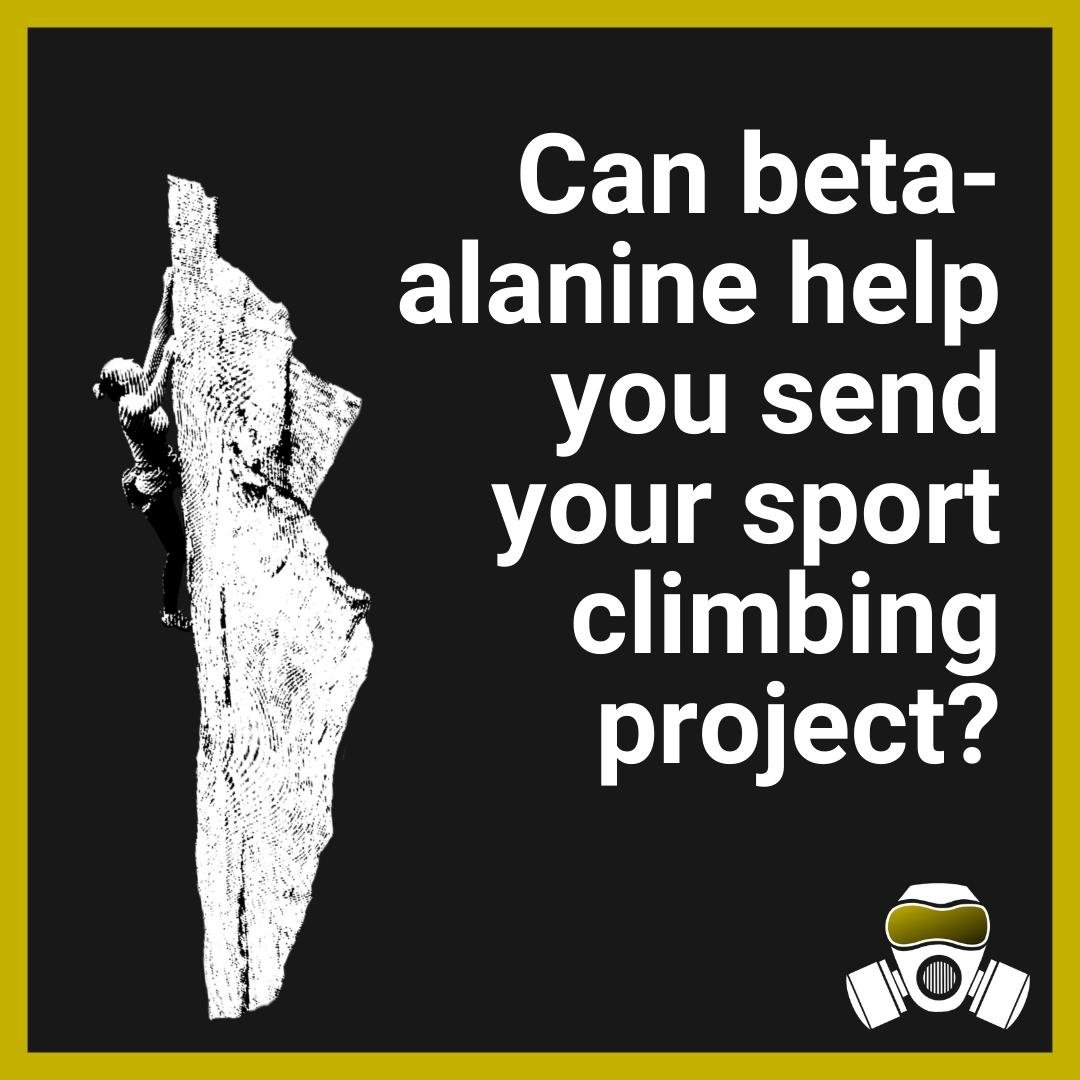

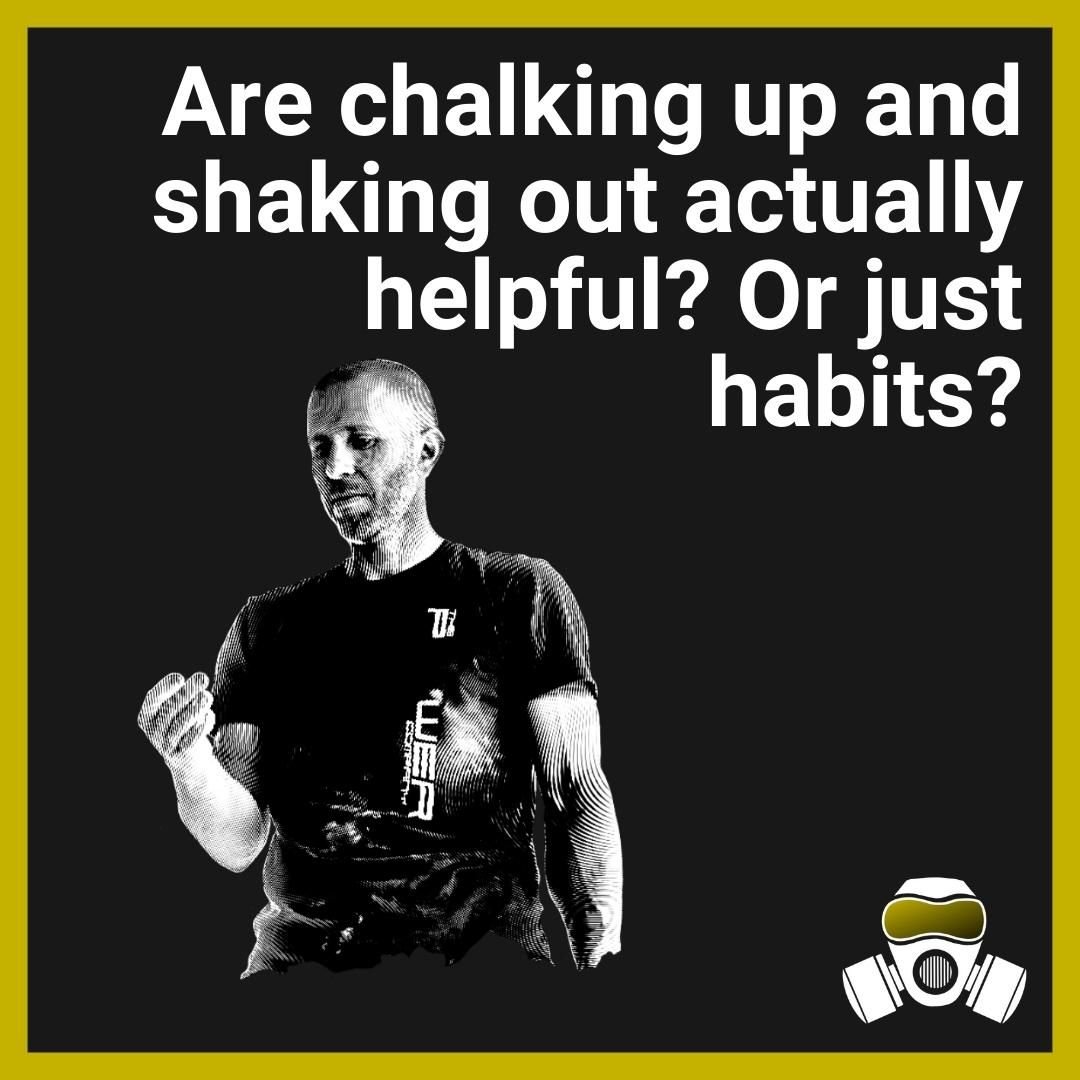
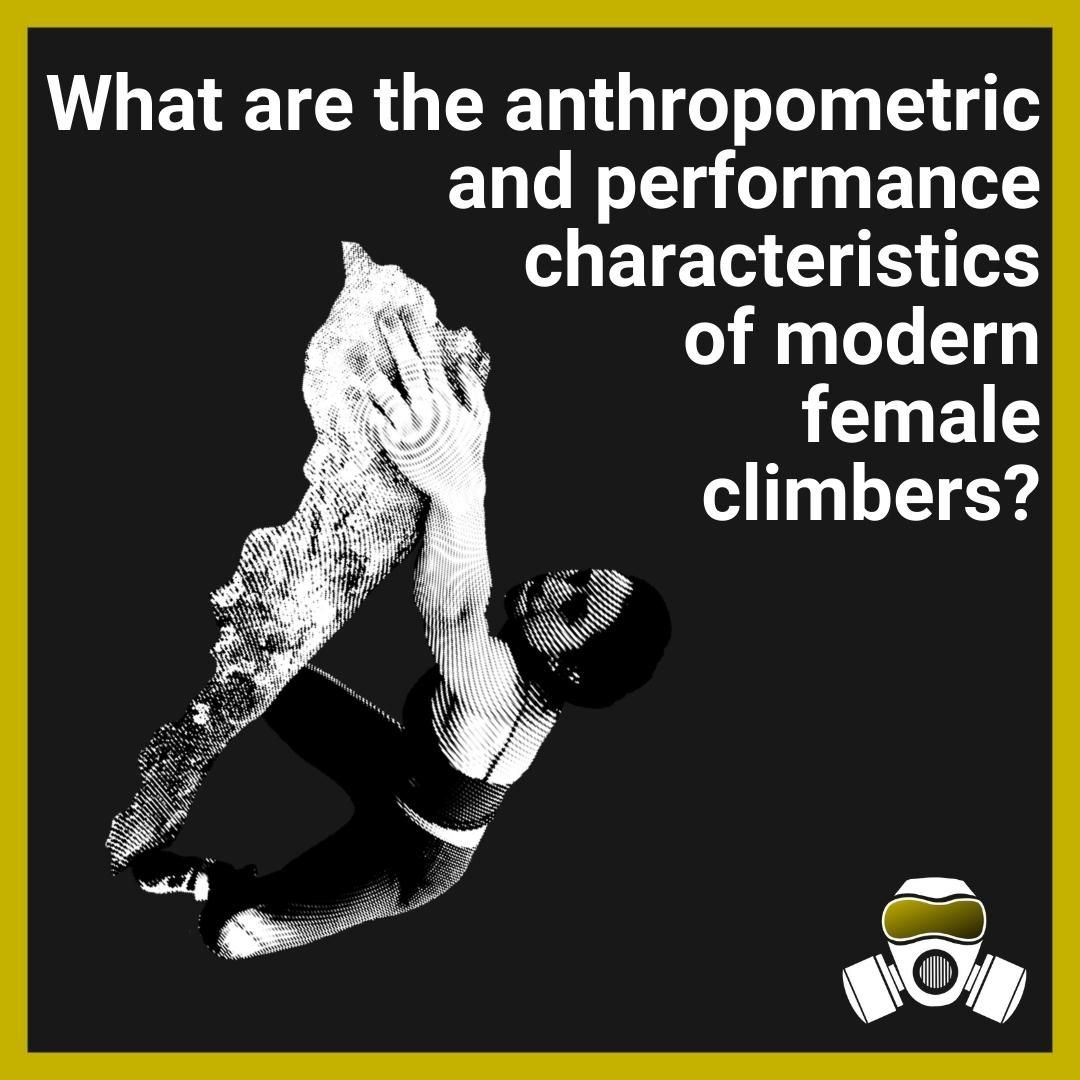


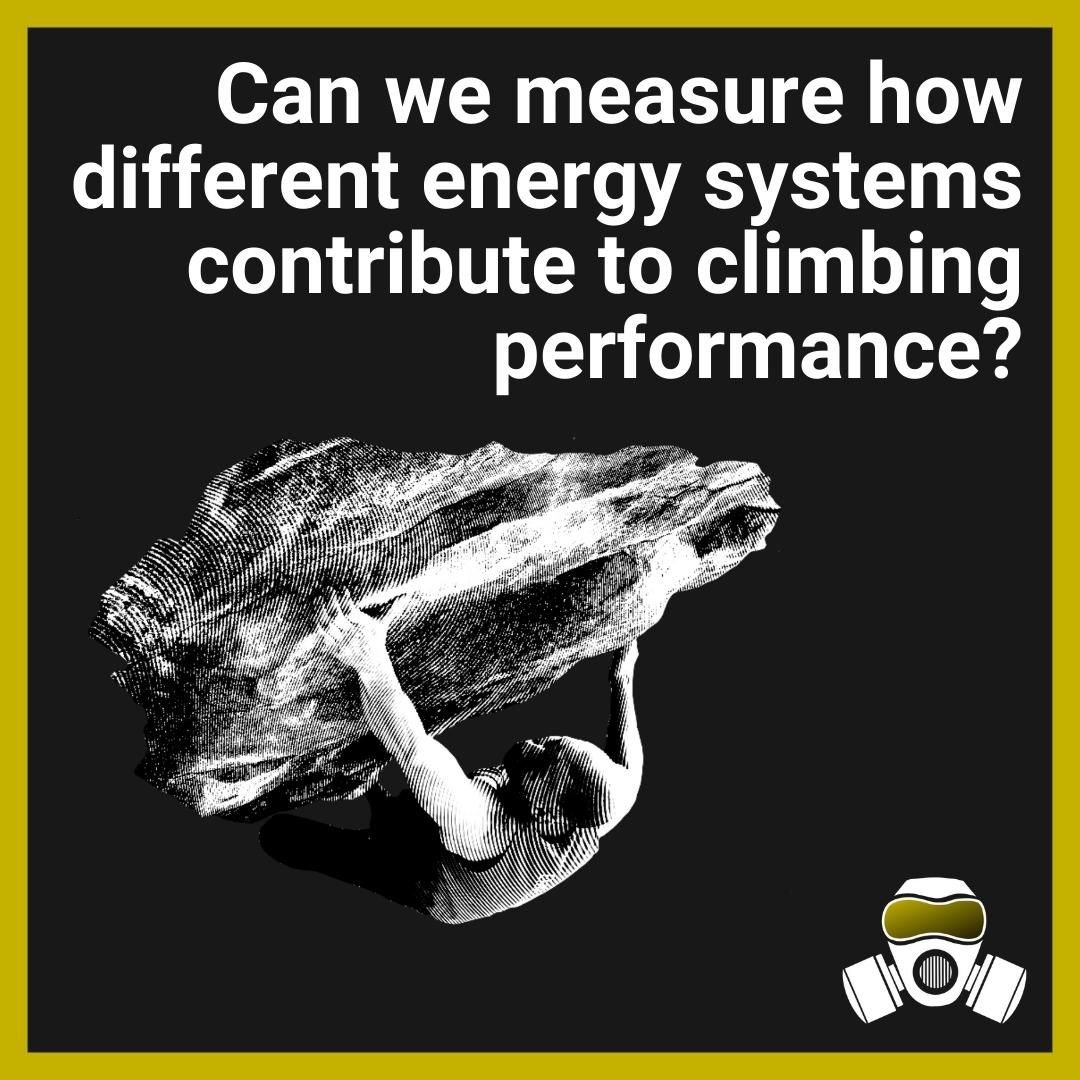
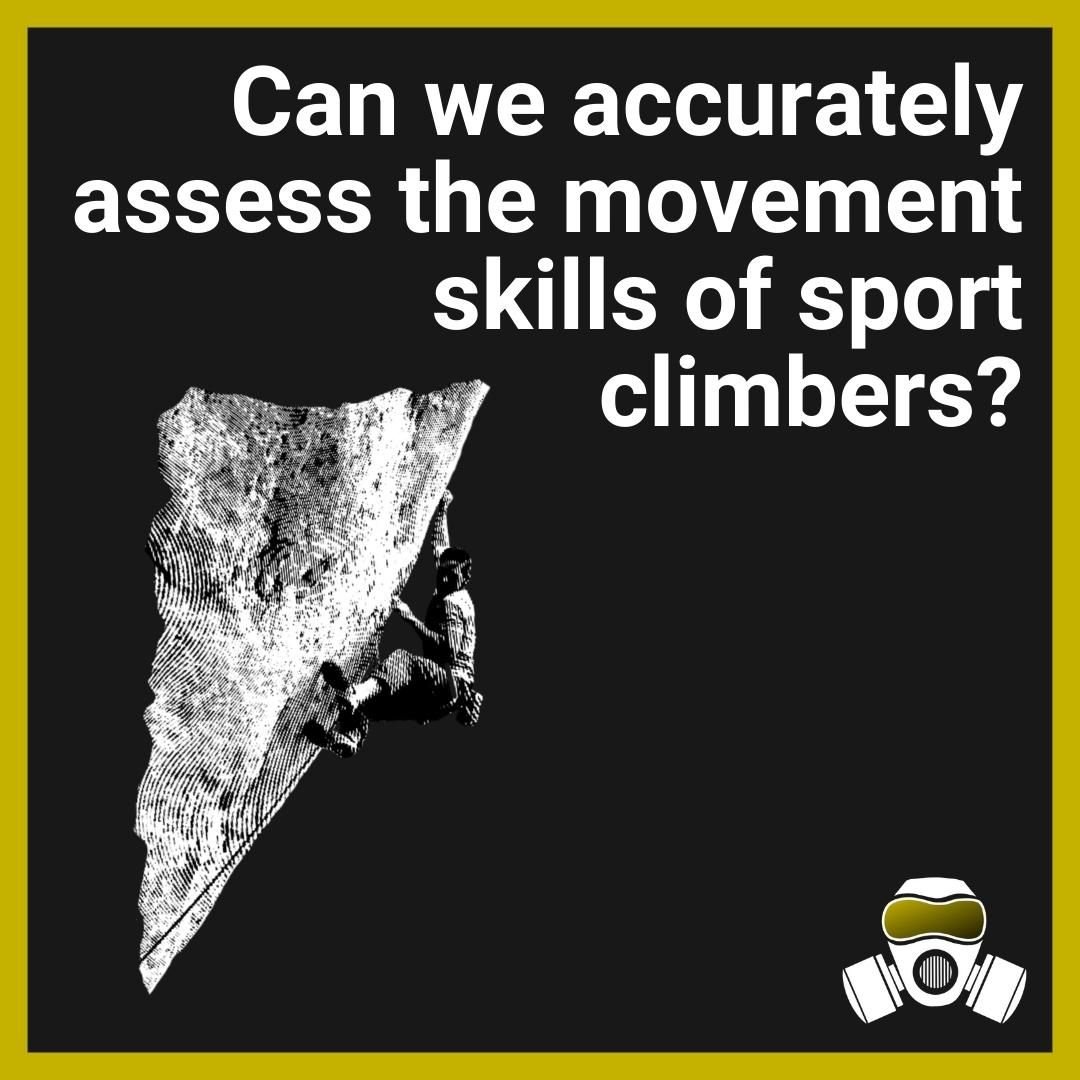
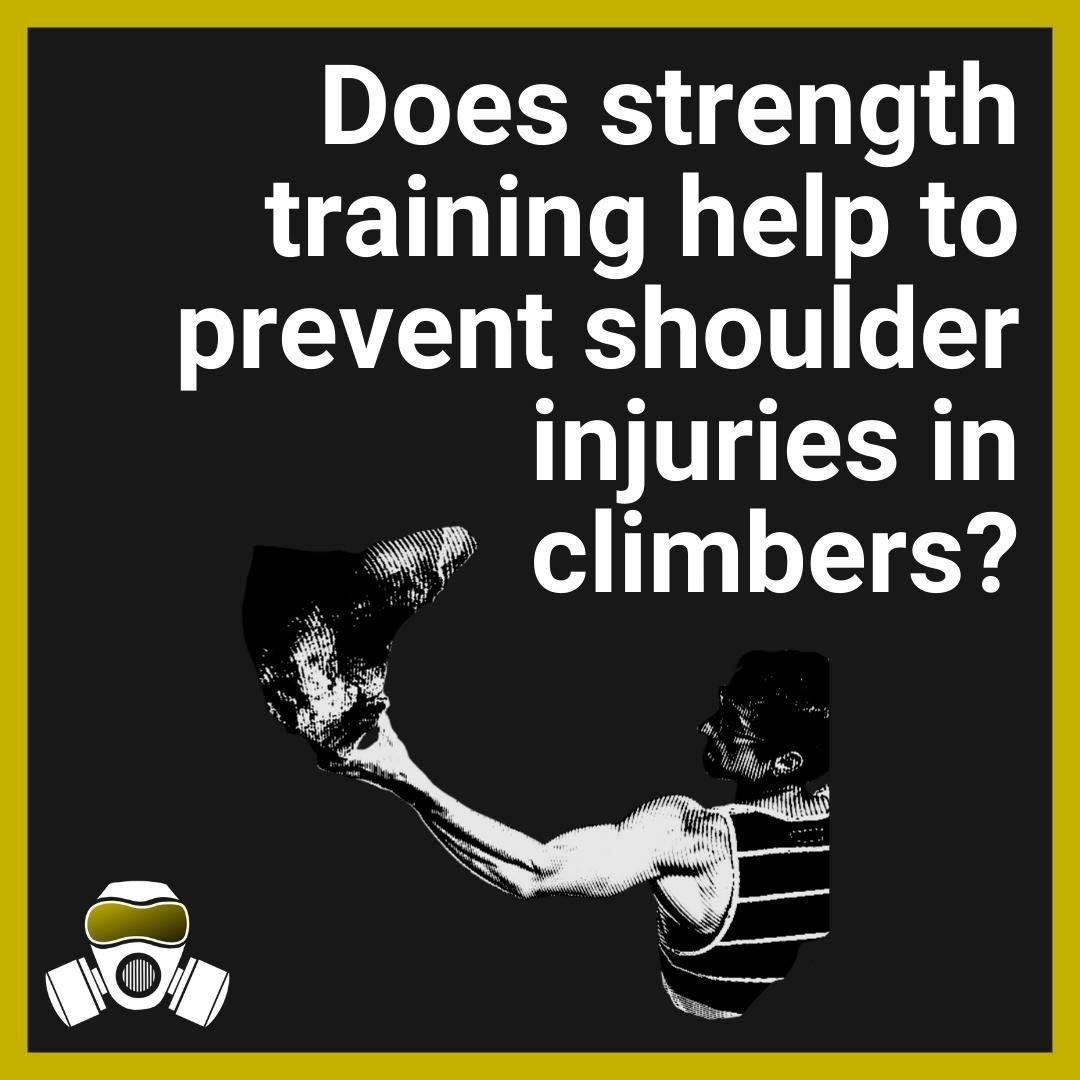







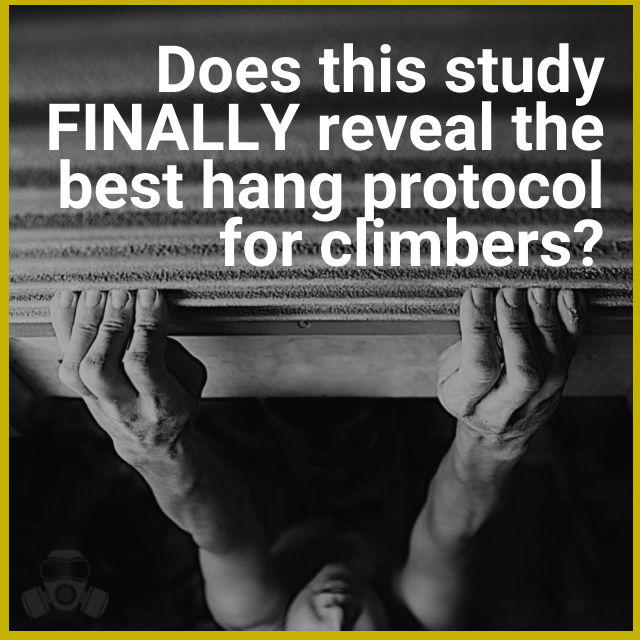

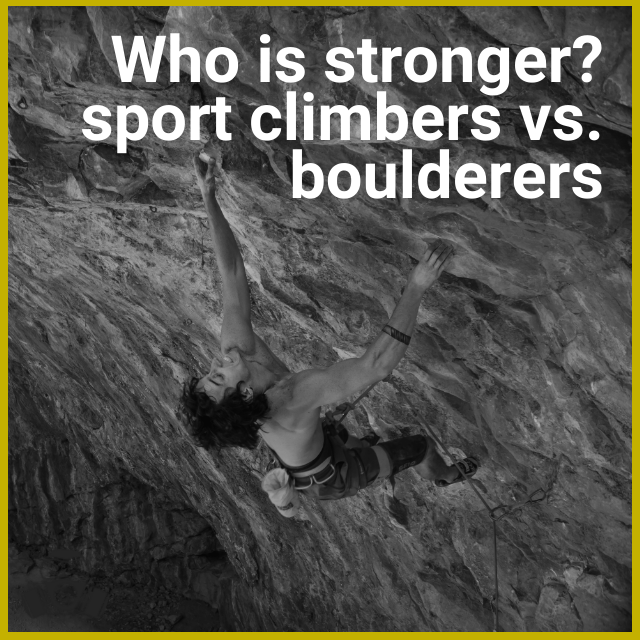

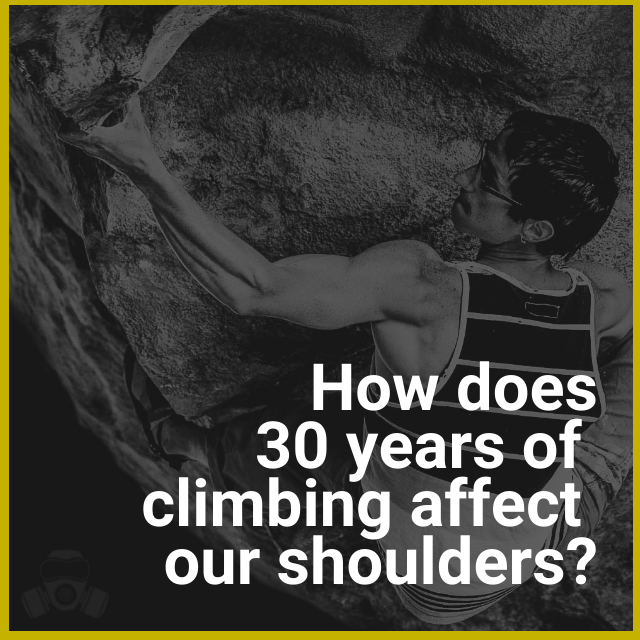

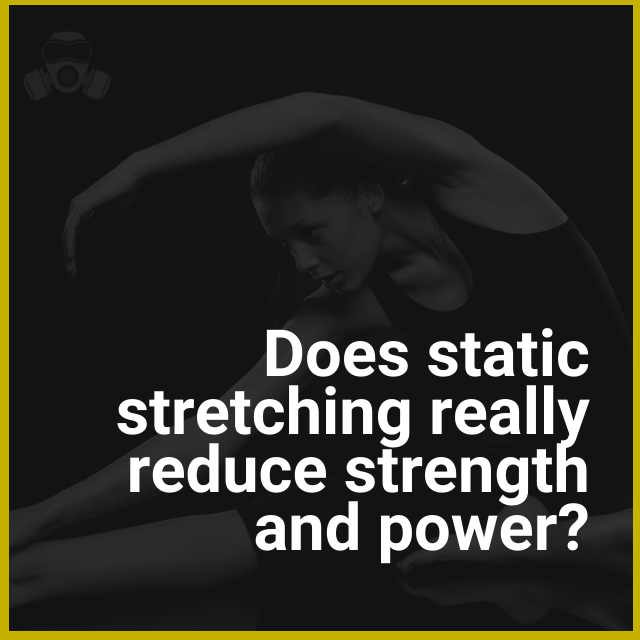


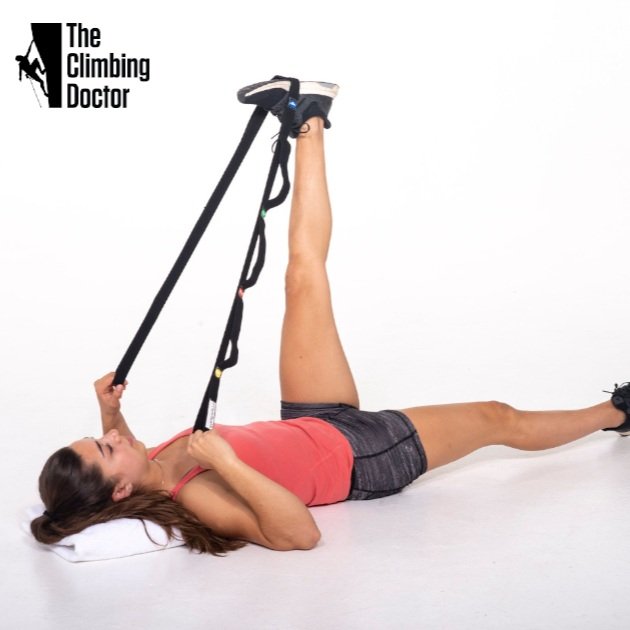



Explaining the science and calling out the misinterpretations.